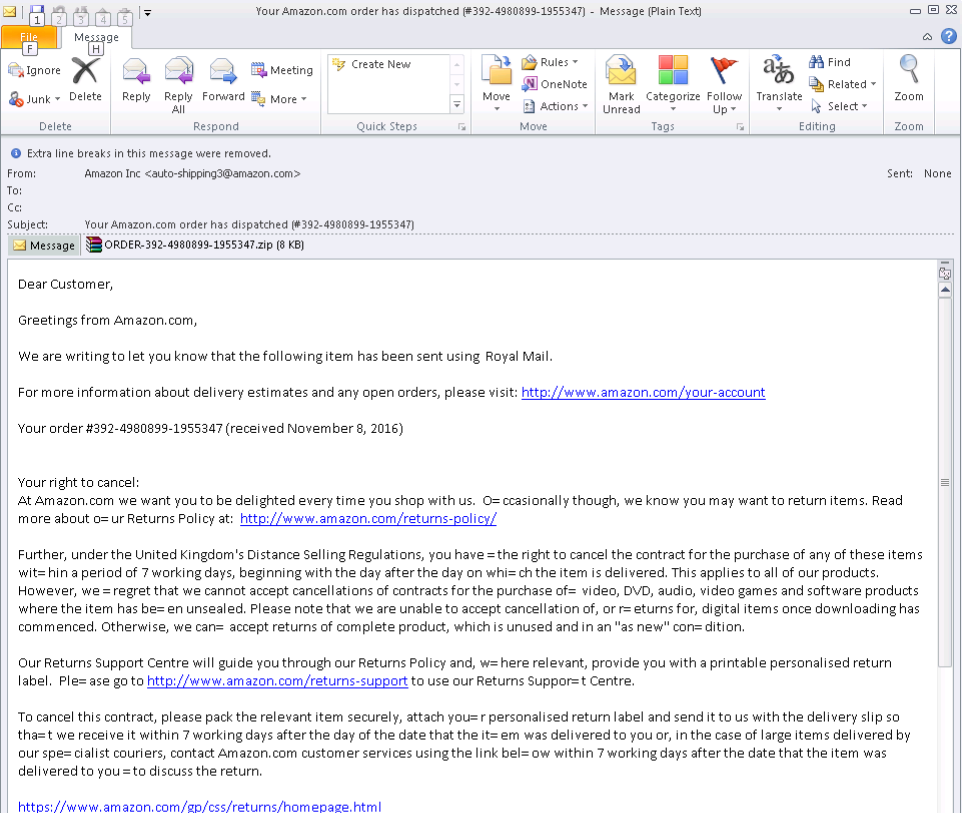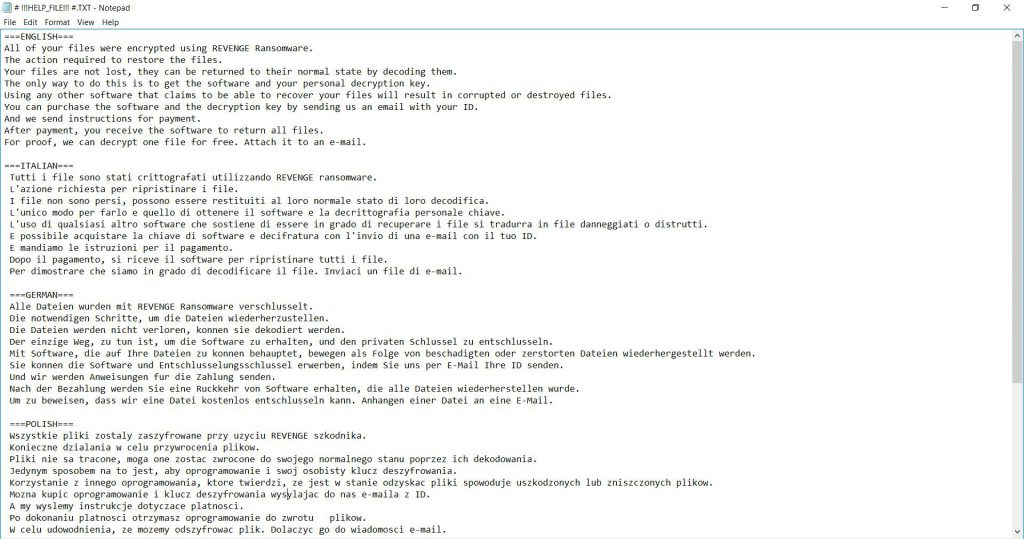 Article created to help you remove the Revenge ransomware virus and restore files encrypted with the .revenge file extension.
Article created to help you remove the Revenge ransomware virus and restore files encrypted with the .revenge file extension.
A well-coded ransomware infection that is using the AES and RSA encryption algorithms has been reported to infect users since March 2017. The ransomware virus Is dubbed Revenge ransomware and aims to encrypt the files on the computers infected by it. After the encryption, Revenge ransomware drops a # !!!HELP_FILE!!! #.TXT note in which it demands a payment to return all the files. The virus creators communicate via e-mail. In case you have become a victim of this ransomware infection, recommendations are to read this article completely.

Threat Summary
| Name |
Revenge |
| Type | Ransomware |
| Short Description | The malware encrypts users files using a strong encryption algorithm, making direct decryption possible only via a unique decryption key available to the cyber-criminals. |
| Symptoms | The user may witness ransom notes and “instructions” linking to a web page and a decryptor. Changed file names and the file-extension .REVENGE has been used. |
| Distribution Method | Via an Exploit kit, Dll file attack, malicious JavaScript or a drive-by download of the malware itself in an obfuscated manner. |
| Detection Tool |
See If Your System Has Been Affected by malware
Download
Malware Removal Tool
|
| User Experience | Join our forum to Discuss Revenge. |
| Data Recovery Tool | Windows Data Recovery by Stellar Phoenix Notice! This product scans your drive sectors to recover lost files and it may not recover 100% of the encrypted files, but only few of them, depending on the situation and whether or not you have reformatted your drive. |

Revenge Ransomware – How Does It Infect
For this virus to become active and infect an increasing number of Windows users’ multiple techniques are reportedly used. One of them is to utilize malicious files that contain either the Rig Exploit Kit or EiTest kit, web-injectors and fake updates for the infection. Such may be spread by being added as web links or malicious e-mail attachments in archives. The e-mails accompanying those attachments may contain deceptive messages that aim to trick the user into opening them, for instance:
After the user opens the malicious e-mail attachment, Revenge ransomware becomes activated and multiple malicious files are downloaded onto the computer of the user:
- Rig-EK.swf
- Svchost.exe
- {random named file}.exe
- {random named file(2)}.exe
- {random named file(3)}.exe
- {random named file}.bin.exe
- # !!!HELP_FILE!!! #.TXT
Most of the files are located in the %AppData% dorectory. But there is also the situation with malicious files that are located in the %Windows NT% directory.

Revenge Ransomware – Infection Analysis
After the infection by Revenge ransomware has been initiated, the virus begins to perform multiple different types of modifications to the computer, starting with the executing of administrative Windows commands in the Command Prompt without the user noticing. The commands are reported by researchers to be the following:
→ /C vssadmin.exe Delete Shadows /All /Quiet
/C bcdedit /set {default} recoveryenabled No
/C bcdedit /set {default} bootstatuspolicy ignoreallfailures
/C net stop vss
/C vssadmin.exe Delete Shadows /All /Quiet
/C net stop vss
These commands are executed with the one and only purpose to stop the volume shadow service and delete the volume shadow copies (backed up files) in a quiet mode, without the user even seeing it.
In the meantime, Revenge ransomware also establishes connection with the following hosts:
- dfg.stickneylodge.com (217.107.34.86)
- 109.236.87.201
- www.everythingcebu.com
The virus also performs multiple other modifications, such as changing the functionality of the autorun service to run malicious executables on system boot. Revenge ransomware also steals confidential information from the web browsers of the infected computer and this may even include passwords and login usernames. This activity is very typical for evolved ransomware viruses, known as doxware.

Revenge Ransomware – Encryption Process
For the encryption of Revenge ransomware, multiple different processes are initiated in the Windows Task Manager to ensure that it is uninterrupted. The encryption procedure targets over 400 different types of files, including pictures, archives, documents, videos and other widely used content. When we put together all of the file extensions together, the list of encrypted files, if detected, becomes quite big:
.1CD, .3DM, .3DS, .3FR, .3G2, .3GP, .3PR, .7Z, .7ZIP, .AAC, .AB4, .ABD, .ACC,.ACCDB, .ACCDE, .ACCDR, .ACCDT, .ACH, .ACR, .ACT, .ADB, .ADP, .ADS, .AGDL, .AI, .AIFF, .AIT, .AL, .AOI, .APJ, .APK, .ARW, .ASCX, .ASF, .ASM, .ASP, .ASPX, .ASSET, .ASX, .ATB, .AVI, .AWG, .BACK, .BACKUP, .BACKUPDB, .BAK, .BANK, .BAY, .BDB, .BGT, .BIK, .BIN, .BKP, .BLEND, .BMP, .BPW, .BSA, .C, .CASH, .CDB, .CDF, .CDR, .CDR3, .CDR4, .CDR5, .CDR6, .CDRW, .CDX, .CE1, .CE2, .CER, .CFG, .CFN, .CGM, .CIB, .CLASS, .CLS, .CMT, .CONFIG, .CONTACT, .CPI, .CPP, .CR2, .CRAW, .CRT, .CRW, .CRY, .CS, .CSH, .CSL, .CSS, .CSV, .D3DBSP, .DAC, .DAS, .DAT, .DB .DB_JOURNAL, .DB3, .DBF, .DBX, .DC2, .DCR, .DCS, .DDD, .DDOC, .DDRW, .DDS, .DEF, .DER, .DES, .DESIGN, .DGC, .DGN, .DIT, .DJVU, .DNG, .DOC, .DOCM, .DOCX, .DOT, .DOTM, .DOTX, .DRF, .DRW, .DTD, .DWG, .DXB, .DXF, .DXG, .EDB, .EML, .EPS, .ERBSQL, .ERF, .EXF, .FDB, .FFD, .FFF, .FH, .FHD, .FLA, .FLAC, .FLB, .FLF, .FLV, .FLVV, .FORGE, .FPX, .FXG, .GBR, .GHO, .GIF, .GRAY, .GREY, .GROUPS, .GRY, .H, .HBK, .HDD, .HPP, .HTML, .IBANK, .IBD, .IBZ, .IDX, .IIF, .IIQ, .INCPAS, .INDD, .INFO, .INFO_, .IWI, .JAR, .JAVA, .JNT, .JPE, .JPEG, .JPG, .JS, .JSON, .K2P, .KC2, .KDBX, .KDC, .KEY, .KPDX, .KWM, .LACCDB, .LBF, .LCK, .LDF, .LIT, .LITEMOD, .LITESQL, .LOCK, .LTX, .LUA, .M, .M2TS, .M3U, .M4A, .M4P, .M4V, .MA, .MAB, .MAPIMAIL, .MAX, .MBX, .MD, .MDB, .MDC, .MDF, .MEF, .MFW, .MID, .MKV, .MLB, .MMW, .MNY, .MONEY, .MONEYWELL, .MOS, .MOV, .MP3, .MP4, .MPEG, .MPG, .MRW, .MSF, .MSG, .MTS, .MYD, .ND, .NDD, .NDF, .NEF, .NK2, .NOP, .NRW, .NS2, .NS3, .NS4, .NSD, .NSF, .NSG, .NSH, .NVRAM, .NWB, .NX2, .NXL, .NYF, .OAB, .OBJ, .ODB, .ODC, .ODF, .ODG, .ODM, .ODP, .ODS, .ODT, .OGG, .OIL, .OMG, .ONE, .ORF, .OST, .OTG, .OTH, .OTP, .OTS, .OTT, .P12, .P7B, .P7C, .PAB, .PAGES, .PAS, .PAT, .PBF, .PCD, .PCT, .PDB, .PDD, .PDF, .PEF, .PFX, .PHP, .PIF, .PL, .PLC, .PLUS_MUHD, .PM!, .PM, .PMI, .PMJ, .PML, .PMM, .PMO, .PMR, .PNC, .PND, .PNG, .PNX, .POT, .POTM, .POTX, .PPAM, .PPS, .PPSM, .PPSX, .PPT, .PPTM, .PPTX, .PRF, .PRIVATE, .PS, .PSAFE3, .PSD, .PSPIMAGE, .PST, .PTX, .PUB, .PWM, .PY, .QBA, .QBB, .QBM, .QBR, .QBW, .QBX, .QBY, .QCOW, .QCOW2, .QED, .QTB, .R3D, .RAF, .RAR, .RAT, .RAW, .RDB, .RE4, .RM, .RTF, .RVT, .RW2, .RWL, .RWZ, .S3DB, .SAFE, .SAS7BDAT, .SAV, .SAVE, .SAY, .SD0, .SDA, .SDB, .SDF, .SH, .SLDM, .SLDX, .SLM, .SQL, .SQLITE, .SQLITE3, .SQLITEDB, .SQLITE-SHM, .SQLITE-WAL, .SR2, .SRB, .SRF, .SRS, .SRT, .SRW, .ST4, .ST5, .ST6, .ST7, .ST8, .STC, .STD, .STI, .STL, .STM, .STW, .STX, .SVG, .SWF, .SXC, .SXD, .SXG, .SXI, .SXM, .SXW, .TAX, .TBB, .TBK, .TBN, .TEX, .TGA, .THM, .TIF, .TIFF, .TLG, .TLX, .TXT, .UPK, .USR, .VBOX, .VDI, .VHD, .VHDX, .VMDK, .VMSD, .VMX, .VMXF, .VOB, .VPD, .VSD, .WAB, .WAD, .WALLET, .WAR, .WAV, .WB2, .WMA, .WMF, .WMV, .WPD, .WPS, .X11, .X3F, .XIS, .XLA, .XLAM, .XLK, .XLM, .XLR, .XLS, .XLSB, .XLSM, .XLSX, .XLT, .XLTM, .XLTX, .XLW, .XML, .XPS, .XXX, .YCBCRA, .YUV, .ZIP Source: id-ransomware.blogspot.bg
For the encryption process, Revenge ransomware reportedly uses two types of encryption algorithms which are both very strong:
- RSA-1024
- AES-256
For the specific encryption process of the files, the AES cipher may be used. Bytes of the original files are replaced with encrypted data and the files become no longer openable. After the procedure is complete, the RSA cipher may be additionally applied to generate unique decryption keys, which makes decryption even more difficult and highly unlikely.
The files are appended the .revenge file extension after the encryption process has completed and they may also contain a victim id, the file name in an encrypted format, a 8 character string and another filename in an 8 character encrypted format and after all of these, the files have the extension appended. They may look like the following:
After the encryption process is complete, the # !!!HELP_FILE!!! #.TXT appears on the infected computer. It has the same message written in 5 languages (English, Italian, German, Polish, Korean):

Remove Revenge Ransomware and Restore .REVENGE Files
Before attempting any removal of this ransomware infections, malware researchers strongly recommend to focus on backing up the files that have been encrypted by this ransomware infection, just in case.
Then, we advise you to follow the step-by-step removal guide below which will show you how to remove the Revenge ransomware infection from your computer permanently. In case you lack the experience to perform a manual removal, experts always advise taking the approach that is conducted automatically. It includes the download and installation of an advanced anti-malware program which will take care of the Revenge virus swiftly and protect your computer in the future too.
After having already taken care of the malicious objects dropped by Revenge on your computer, recommendations are to try and restore your files using alternative tools, like the ones we suggested in step “2. Restore files encrypted by Revenge” below. These tools are in no way guarantee that you will recover all your encrypted data, however they are a good alternative, because at least some of the files can be recovered this way.
- Step 1
- Step 2
- Step 3
- Step 4
- Step 5
Step 1: Scan for Revenge with SpyHunter Anti-Malware Tool



Ransomware Automatic Removal - Video Guide
Step 2: Uninstall Revenge and related malware from Windows
Here is a method in few easy steps that should be able to uninstall most programs. No matter if you are using Windows 10, 8, 7, Vista or XP, those steps will get the job done. Dragging the program or its folder to the recycle bin can be a very bad decision. If you do that, bits and pieces of the program are left behind, and that can lead to unstable work of your PC, errors with the file type associations and other unpleasant activities. The proper way to get a program off your computer is to Uninstall it. To do that:


 Follow the instructions above and you will successfully delete most unwanted and malicious programs.
Follow the instructions above and you will successfully delete most unwanted and malicious programs.
Step 3: Clean any registries, created by Revenge on your computer.
The usually targeted registries of Windows machines are the following:
- HKEY_LOCAL_MACHINE\Software\Microsoft\Windows\CurrentVersion\Run
- HKEY_CURRENT_USER\Software\Microsoft\Windows\CurrentVersion\Run
- HKEY_LOCAL_MACHINE\Software\Microsoft\Windows\CurrentVersion\RunOnce
- HKEY_CURRENT_USER\Software\Microsoft\Windows\CurrentVersion\RunOnce
You can access them by opening the Windows registry editor and deleting any values, created by Revenge there. This can happen by following the steps underneath:


 Tip: To find a virus-created value, you can right-click on it and click "Modify" to see which file it is set to run. If this is the virus file location, remove the value.
Tip: To find a virus-created value, you can right-click on it and click "Modify" to see which file it is set to run. If this is the virus file location, remove the value.
Before starting "Step 4", please boot back into Normal mode, in case you are currently in Safe Mode.
This will enable you to install and use SpyHunter 5 successfully.
Step 4: Boot Your PC In Safe Mode to isolate and remove Revenge





Step 5: Try to Restore Files Encrypted by Revenge.
Method 1: Use STOP Decrypter by Emsisoft.
Not all variants of this ransomware can be decrypted for free, but we have added the decryptor used by researchers that is often updated with the variants which become eventually decrypted. You can try and decrypt your files using the instructions below, but if they do not work, then unfortunately your variant of the ransomware virus is not decryptable.
Follow the instructions below to use the Emsisoft decrypter and decrypt your files for free. You can download the Emsisoft decryption tool linked here and then follow the steps provided below:
1 Right-click on the decrypter and click on Run as Administrator as shown below:

2. Agree with the license terms:

3. Click on "Add Folder" and then add the folders where you want files decrypted as shown underneath:

4. Click on "Decrypt" and wait for your files to be decoded.

Note: Credit for the decryptor goes to Emsisoft researchers who have made the breakthrough with this virus.
Method 2: Use data recovery software
Ransomware infections and Revenge aim to encrypt your files using an encryption algorithm which may be very difficult to decrypt. This is why we have suggested a data recovery method that may help you go around direct decryption and try to restore your files. Bear in mind that this method may not be 100% effective but may also help you a little or a lot in different situations.
Simply click on the link and on the website menus on the top, choose Data Recovery - Data Recovery Wizard for Windows or Mac (depending on your OS), and then download and run the tool.
Revenge-FAQ
What is Revenge Ransomware?
Revenge is a ransomware infection - the malicious software that enters your computer silently and blocks either access to the computer itself or encrypt your files.
Many ransomware viruses use sophisticated encryption algorithms to make your files inaccessible. The goal of ransomware infections is to demand that you pay a ransom payment to get access to your files back.
What Does Revenge Ransomware Do?
Ransomware in general is a malicious software that is designed to block access to your computer or files until a ransom is paid.
Ransomware viruses can also damage your system, corrupt data and delete files, resulting in the permanent loss of important files.
How Does Revenge Infect?
Via several ways.Revenge Ransomware infects computers by being sent via phishing emails, containing virus attachment. This attachment is usually masked as an important document, like an invoice, bank document or even a plane ticket and it looks very convincing to users.
Another way you may become a victim of Revenge is if you download a fake installer, crack or patch from a low reputation website or if you click on a virus link. Many users report getting a ransomware infection by downloading torrents.
How to Open .Revenge files?
You can't without a decryptor. At this point, the .Revenge files are encrypted. You can only open them once they are decrypted using a specific decryption key for the particular algorithm.
What to Do If a Decryptor Does Not Work?
Do not panic, and backup the files. If a decryptor did not decrypt your .Revenge files successfully, then do not despair, because this virus is still new.
Can I Restore ".Revenge" Files?
Yes, sometimes files can be restored. We have suggested several file recovery methods that could work if you want to restore .Revenge files.
These methods are in no way 100% guaranteed that you will be able to get your files back. But if you have a backup, your chances of success are much greater.
How To Get Rid of Revenge Virus?
The safest way and the most efficient one for the removal of this ransomware infection is the use a professional anti-malware program.
It will scan for and locate Revenge ransomware and then remove it without causing any additional harm to your important .Revenge files.
Can I Report Ransomware to Authorities?
In case your computer got infected with a ransomware infection, you can report it to the local Police departments. It can help authorities worldwide track and determine the perpetrators behind the virus that has infected your computer.
Below, we have prepared a list with government websites, where you can file a report in case you are a victim of a cybercrime:
Cyber-security authorities, responsible for handling ransomware attack reports in different regions all over the world:
Germany - Offizielles Portal der deutschen Polizei
United States - IC3 Internet Crime Complaint Centre
United Kingdom - Action Fraud Police
France - Ministère de l'Intérieur
Italy - Polizia Di Stato
Spain - Policía Nacional
Netherlands - Politie
Poland - Policja
Portugal - Polícia Judiciária
Greece - Cyber Crime Unit (Hellenic Police)
India - Mumbai Police - CyberCrime Investigation Cell
Australia - Australian High Tech Crime Center
Reports may be responded to in different timeframes, depending on your local authorities.
Can You Stop Ransomware from Encrypting Your Files?
Yes, you can prevent ransomware. The best way to do this is to ensure your computer system is updated with the latest security patches, use a reputable anti-malware program and firewall, backup your important files frequently, and avoid clicking on malicious links or downloading unknown files.
Can Revenge Ransomware Steal Your Data?
Yes, in most cases ransomware will steal your information. It is a form of malware that steals data from a user's computer, encrypts it, and then demands a ransom in order to decrypt it.
In many cases, the malware authors or attackers will threaten to delete the data or publish it online unless the ransom is paid.
Can Ransomware Infect WiFi?
Yes, ransomware can infect WiFi networks, as malicious actors can use it to gain control of the network, steal confidential data, and lock out users. If a ransomware attack is successful, it could lead to a loss of service and/or data, and in some cases, financial losses.
Should I Pay Ransomware?
No, you should not pay ransomware extortionists. Paying them only encourages criminals and does not guarantee that the files or data will be restored. The better approach is to have a secure backup of important data and be vigilant about security in the first place.
What Happens If I Don't Pay Ransom?
If you don't pay the ransom, the hackers may still have access to your computer, data, or files and may continue to threaten to expose or delete them, or even use them to commit cybercrimes. In some cases, they may even continue to demand additional ransom payments.
Can a Ransomware Attack Be Detected?
Yes, ransomware can be detected. Anti-malware software and other advanced security tools can detect ransomware and alert the user when it is present on a machine.
It is important to stay up-to-date on the latest security measures and to keep security software updated to ensure ransomware can be detected and prevented.
Do Ransomware Criminals Get Caught?
Yes, ransomware criminals do get caught. Law enforcement agencies, such as the FBI, Interpol and others have been successful in tracking down and prosecuting ransomware criminals in the US and other countries. As ransomware threats continue to increase, so does the enforcement activity.
About the Revenge Research
The content we publish on SensorsTechForum.com, this Revenge how-to removal guide included, is the outcome of extensive research, hard work and our team’s devotion to help you remove the specific malware and restore your encrypted files.
How did we conduct the research on this ransomware?
Our research is based on an independent investigation. We are in contact with independent security researchers, and as such, we receive daily updates on the latest malware and ransomware definitions.
Furthermore, the research behind the Revenge ransomware threat is backed with VirusTotal and the NoMoreRansom project.
To better understand the ransomware threat, please refer to the following articles which provide knowledgeable details.
As a site that has been dedicated to providing free removal instructions for ransomware and malware since 2014, SensorsTechForum’s recommendation is to only pay attention to trustworthy sources.
How to recognize trustworthy sources:
- Always check "About Us" web page.
- Profile of the content creator.
- Make sure that real people are behind the site and not fake names and profiles.
- Verify Facebook, LinkedIn and Twitter personal profiles.


















BS DIAS EWSTOYB INFECTADO CON EL VIRUS, TODOS MIS ARCHIVOS TIENEN EXTENSIÓN .SAGE Y QUEDARON INUTILES. NO LOS PUEDO ABRIR. NO PUEDO RESTAURAR POR QUE BORRO TODOS LO S PUNTOS DE RESTAURACION, BAJE LA HERRAMIENTA SPY HUNTER V 4.0, ELIMINO ALGUNAS AMENAZAS PERO NINGUNA CON RELACION A ESE VIRUS. BAJE OTRA HERRAMIENTA PARA RECUPERACION DE ARCHIVOS PERO NO ME RECUPERO TODO. ¿ Hay alguna manera de restaurar los archivos a su estado original? o el virus borra el archivo original y crea una copia con la extension *.sage? entonces toca recuperar con software de recuperacion de archivos?. muchas gracias. mi Nombre es carlos mario nieto de santa marta, magdalena, colombia Email; cnietogomez@hotmail.com, 3004823295 – 4224508 – 4203362
hello, from what you wrote, i understand that you were infected by Sage ransomware. For more information on sage, please visit the following article:
sensorstechforum.com/sage-2-2-ransomware-restore-sage-virus-files/